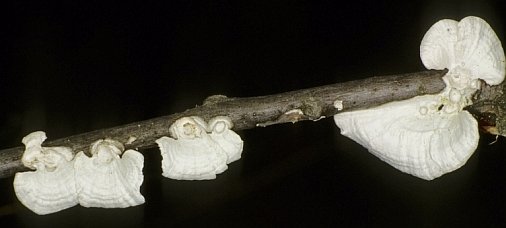Poronidulus conchifer (Schwein.) Murrill, the ‘Little Nest Polypore’, growing on an elm branch.
Synonyms
Boletus conchifer Schwein.
Coriolus conchifer (Schwein.) G. Cunn.
Microporus conchifer (Schwein.) Kuntze
Polyporus conchifer (Schwein.) Fr.
Polystictus conchifer (Schwein.) Cooke
Trametes conchifer (Schwein.) Pilát
Common name
Little nest polypore
Description
WIlliam Alphonso Murrill’s 100+-year old description of Poronidulus conchifer (referred to as an older synonym, Boletus conchifer) is still valid today:
“…a very common and abundant species on dead elm branches. The development of the fruit body is peculiar, being in two stages. the first ending with the formation of a cup-shaped sterile body, from which the fruit-body proper develops. This preliminary cap begins as a knot of whitish mycelium which soon ceases to grow at the center, while the hyaline borders continue to grow upward and form a cup resembling species of Nidularia. The margin of the cup is thin and entire or undulate and becomes darker like the center when the limit of growth is reached, while the concentric zones within very plainly show the progress of the development. The cup varies from deeply infundibuloform to shallow or even flat at times and the central portion which has ceased to grow is much cracked radially to accommodate itself to the growing exterior.
The cap proper usually arises from one side of the cup near the base and expands laterally into a reniform, zonate hymenophore considerably larger than the sterile portion. At times the cap does not develop beyond the surface of the cup and at other times a developed cap becomes proliferous at several points and give rise to new sterile and fertile portions. Since formation of the cups continues throughout the growing season, many are overtaken by winter and are found among the new ones the following spring. The old pilei rarely remain over winter, being fragile and readily devoured by insect larvae.” (Murrill, 1904, p. 425-6)
Fruiting body: when young, is cupulate about 1 cm in diameter, varying in color from pure white to grey to dark brown, and marked with dark concentric rings.
Cap: in age, sessile, fan- or kidney-shaped (reniform), approximately 1-3 x 1-4 cm x 1-3 mm and generally narrowly attached (substipiate); coriaceous, white to yellowish, glabrous, zonate or azonate, the margin very thin and acute
Context: white, fibrous
Tubes: short, thin-walled, mouths polygonal.
Spores: ellipsoidal, smooth, hyaline.
The species is easily recognized by the sterile (non-spore bearing), concentrically zoned, cup- or vase-shaped structure, 4-6 mm in diameter, and 5 mm deep. These function as ‘splash cups’ that help disperse specialized spores called oidia.
Habitat: common on dead elm branches, from September until winter. Common in North America.
Polysaccharides extracted from the mycelial culture of P. conchifer and administered intraperitoneally into white mice at a dosage of 300 mg/kg inhibited the growth of Sarcoma 180 and Ehrlich solid cancers by 80% and 90%, respectively (Ohtsuka et al., 1973).

My name is Austin Collins.
I've dedicated my life to Mushrooms.
I believe Mushrooms are the best kept secret when it comes to health and well being.
For that reason, I would like to share a company with you that in my opinion makes the best mushroom products on the market.
The company is called Noomadic Herbals, my favorite supplement they make is called "Mushroom Total".
I take their products every day and they have helped me think better and have more energy. Give them a try.
-Austin
Web
This patent describes a process for manufacturing antitumor protein-bound polysaccharides, and mentions that P. conchifer may be used in the process.
There’s a variety of excellent pictures showing different stages of the life cycle here at the Fungi on Wood website.
References
Murrill WA.
The polyporaceae of North America-VII. Hapalopilus, Pycnoporus, and new monotypic genera.
Bulletin of the Torrey Botanical Club. 1904 31(8):415-28.
Ohtsuka S, Ueno S, Yoshikumi C, Hirose F, Ohmura Y, Wada T, Fujii T, Takahashi E.
Polysaccharides having an anticarcinogenic effect and a method of producing them from species of Basidiomycetes.
UK Patent 1331513, 26 September 1973.



Can I please get more information on the healing properties of this mushroom?
Hi Abigail,
This is all the medicinal info we have so far, anything else would just be speculation.